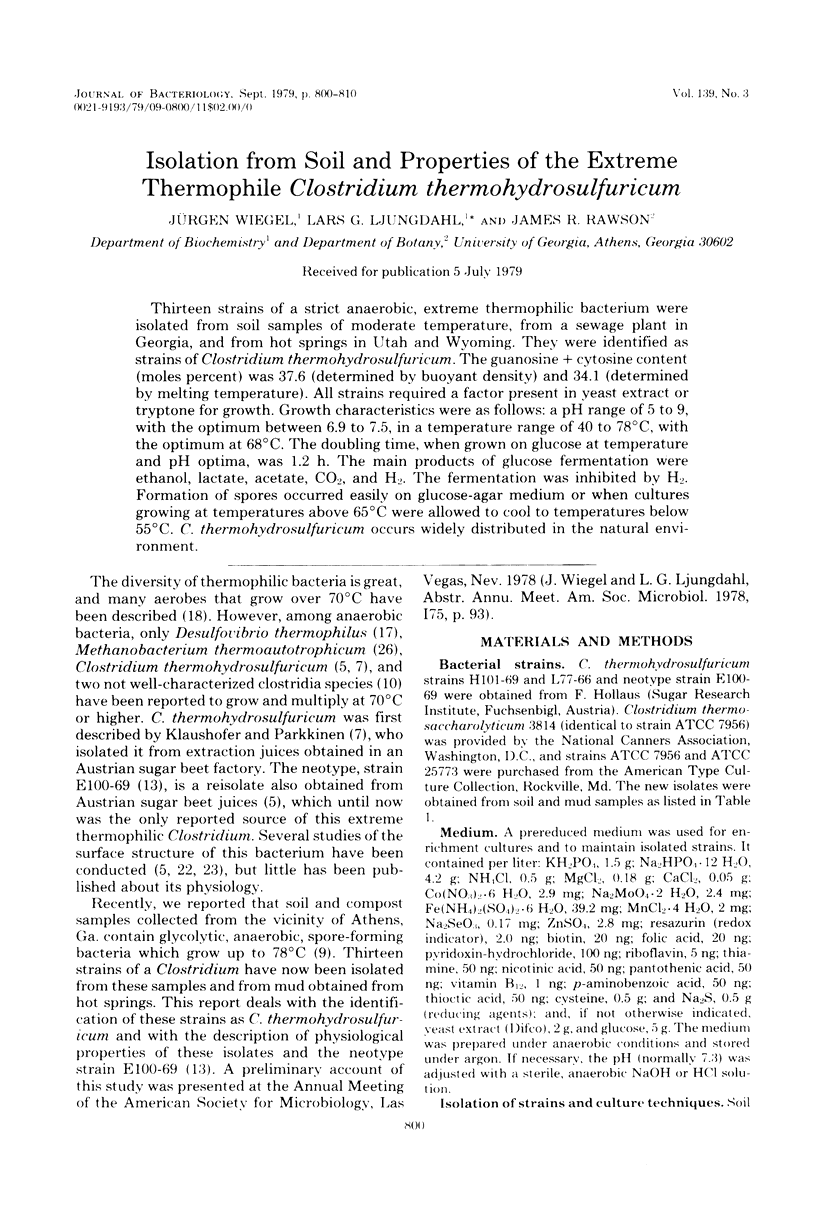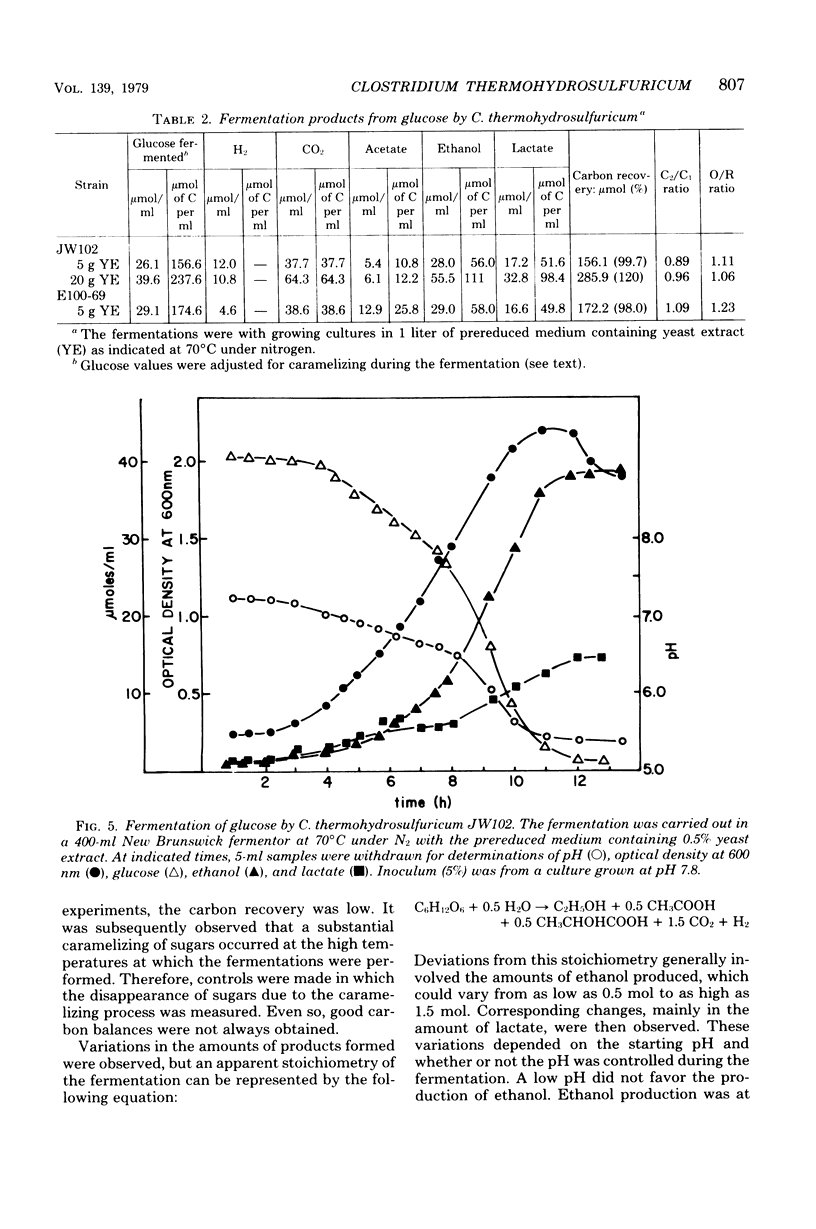Abstract
Thirteen strains of a strict anaerobic, extreme thermophilic bacterium were isolated from soil samples of moderate temperature, from a sewage plant in Georgia, and from hot springs in Utah and Wyoming. They were identified as strains of Clostridium thermohydrosulfuricum. The guanosine + cytosine content (moles percent) was 37.6 (determined by buoyant density) and 34.1 (determined by melting temperature). All strains required a factor present in yeast extract or tryptone growth. Growth characteristics were as follows: a pH range of 5 to 9, with the optimum between 6.9 to 7.5, in a temperature range of 40 to 78 degrees C, with the optimum at 68 degrees C. The doubling time, when grown on glucose at temperature and pH optima, was 1.2 h. The main products of glucose fermentation were ethanol, lactate, acetate, CO2, and H2. The fermentation was inhibited by H2. Formation of spores occurred easily on glucose-agar medium or when cultures growing at temperatures above 65 degrees C were allowed to cool to temperature below 55 degrees C. C. thermohydrosulfuricum occurs widely distributed in the natural environment.
Full text
PDF










Selected References
These references are in PubMed. This may not be the complete list of references from this article.
- Fontaine F. E., Peterson W. H., McCoy E., Johnson M. J., Ritter G. J. A New Type of Glucose Fermentation by Clostridium thermoaceticum. J Bacteriol. 1942 Jun;43(6):701–715. doi: 10.1128/jb.43.6.701-715.1942. [DOI] [PMC free article] [PubMed] [Google Scholar]
- HUNGATE R. E. The anaerobic mesophilic cellulolytic bacteria. Bacteriol Rev. 1950 Mar;14(1):1–49. doi: 10.1128/br.14.1.1-49.1950. [DOI] [PMC free article] [PubMed] [Google Scholar]
- Hollaus F., Sleytr U. On the taxonomy and fine structure of some hyperthermophilic saccharolytic Clostridia. Arch Mikrobiol. 1972;86(2):129–146. doi: 10.1007/BF00413368. [DOI] [PubMed] [Google Scholar]
- Lee C. K., Ordal Z. J. Regulatory effect of pyruvate on the glucose metabolism of Clostridium thermosaccharolyticum. J Bacteriol. 1967 Sep;94(3):530–536. doi: 10.1128/jb.94.3.530-536.1967. [DOI] [PMC free article] [PubMed] [Google Scholar]
- MERCER W. A., VAUGHN R. H. The characteristics of some thermophilic, tartrate-fermenting anaerobes. J Bacteriol. 1951 Jul;62(1):27–37. doi: 10.1128/jb.62.1.27-37.1951. [DOI] [PMC free article] [PubMed] [Google Scholar]
- McClung L. S. Studies on Anaerobic Bacteria: IV. Taxonomy of Cultures of a Thermophilic Species Causing "Swells" of Canned Foods. J Bacteriol. 1935 Feb;29(2):189–203. doi: 10.1128/jb.29.2.189-203.1935. [DOI] [PMC free article] [PubMed] [Google Scholar]
- SCHILDKRAUT C. L., MARMUR J., DOTY P. Determination of the base composition of deoxyribonucleic acid from its buoyant density in CsCl. J Mol Biol. 1962 Jun;4:430–443. doi: 10.1016/s0022-2836(62)80100-4. [DOI] [PubMed] [Google Scholar]
- SWIM H. E., KRAMPITZ L. O. Acetic acid oxidation by Escherichia coli; evidence for the occurrence of a tricarboxylic acid cycle. J Bacteriol. 1954 Apr;67(4):419–425. doi: 10.1128/jb.67.4.419-425.1954. [DOI] [PMC free article] [PubMed] [Google Scholar]
- Schildkraut C. Dependence of the melting temperature of DNA on salt concentration. Biopolymers. 1965;3(2):195–208. doi: 10.1002/bip.360030207. [DOI] [PubMed] [Google Scholar]
- Sjolander N. O. Studies on Anaerobic Bacteria: XII. The Fermentation Products of Clostridium Thermosaccharolyticum. J Bacteriol. 1937 Oct;34(4):419–428. doi: 10.1128/jb.34.4.419-428.1937. [DOI] [PMC free article] [PubMed] [Google Scholar]
- Sleytr U. B., Glauert A. M. Ultrastructure of the cell walls of two closely related clostridia that possess different regular arrays of surface subunits. J Bacteriol. 1976 May;126(2):869–882. doi: 10.1128/jb.126.2.869-882.1976. [DOI] [PMC free article] [PubMed] [Google Scholar]


